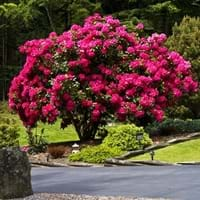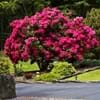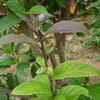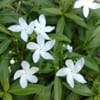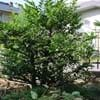Life Span
Perennial
Perennial
Type
Broadleaf Evergreen
Perennial
Origin
Hybrid origin
California
Types
Rhododendron aberconwayi, Rhododendron bulu, Rhododendron kanehirae
Not Available
Habitat
moist forests
Chaparral, River side
USDA Hardiness Zone
5-8
7-10
AHS Heat Zone
Not Available
9-1
Sunset Zone
21,22
H1, 4, 5, 6, 7, 8, 9, 10, 11, 12, 14, 15, 16, 17, 18, 19, 20, 21, 22, 23, 24
Habit
Spreading
Upright/Erect
Minimum Width
Not Available
Flower Color
Red
White, Yellow
Flower Color Modifier
Bicolor
Bicolor
Fruit Color
Green, Tan
Green, Tan
Leaf Color in Spring
Green
Gray Green
Leaf Color in Summer
Green
Gray Green
Leaf Color in Fall
Green
Gray Green
Leaf Color in Winter
Green
Light Green
Leaf Shape
Ovate
Lance shaped
Plant Season
Spring, Summer, Fall, Winter
Spring, Summer
Sunlight
Full Sun, Partial Sun
Full Sun
Type of Soil
Loam, Sand
Loam, Sand
The pH of Soil
Acidic
Neutral, Alkaline
Soil Drainage
Well drained
Well drained
Bloom Time
Late Spring
Early Spring, Spring, Late Spring, Early Summer, Summer
Tolerances
Not Available
Drought
Where to Plant?
Ground
Ground
How to Plant?
From Rhizomes, Seedlings, Stem Planting
Cuttings, Seedlings
Plant Maintenance
Medium
Medium
Watering Requirements
Do Not over Water, Keep ground moist
Needs watering once a week, Water well when planted
In Summer
Consistently
Lots of watering
In Spring
Moderate
Moderate
In Winter
Ample Water
Average Water
Soil pH
Acidic
Neutral, Alkaline
Soil Type
Loam, Sand
Loam, Sand
Soil Drainage Capacity
Well drained
Well drained
Sun Exposure
Full Sun, Partial Sun
Full Sun
Pruning
Prune after flowering, Remove dead or diseased plant parts, Remove deadheads, Remove short twigs
prune nearly to the ground in late fall
Fertilizers
Apply 12-10-18 NPK, General garden fertilizer
organic fertlizers
Pests and Diseases
Azalea leaf gall, Bud blast, Galls, Honey fungus, Leaf Hoppers, Leaf spot, Petal blight, Phytophthora, Powdery mildew, Rust, Silver leaf
Verticillium Wilt
Plant Tolerance
Not Available
Drought
Flower Petal Number
Single
Single
Showy Foliage
No
Not Available
Foliage Texture
Coarse
Not Available
Foliage Sheen
Matte
Not Available
Attracts
Not Available
Bees, Birds, Butterflies
Allergy
Asthma
no allergic reactions
Aesthetic Uses
Showy Purposes
Showy Purposes
Beauty Benefits
Making cosmetics
Not Available
Environmental Uses
Air purification
Air purification
Medicinal Uses
Burns, Chronic fatigue, Cold, Diarrhea, Dysentry, Headache, Rheumatism
antimicrobial, Astringent, Gum Problems, Stomach pain
Part of Plant Used
Whole plant
Flower Stalk
Other Uses
Cosmetics, Employed in herbal medicine, Oil is used for aromatherapy, Oil is used in perfume, soaps, creams, etc., Sometimes used for making wine
Used as Ornamental plant
Used As Indoor Plant
No
No
Used As Outdoor Plant
Yes
Yes
Garden Design
Feature Plant, Hedges, Mixed Border, Screening, Wind Break, Topiary, Bonsai, Espalier
Feature Plant, Groundcover, Mixed Border, Wildflower
Botanical Name
RHODODENDRON
ROMNEYA coulteri
Common Name
Rhododendron
Matilija Poppy
In Hindi
rhododendron
Matilija Poppy
In German
Rhododendron
Matilija Poppy
In French
rhododendron
Matilija Poppy
In Spanish
rododendro
Matilija amapola
In Greek
ροδοδάφνη
Matilija παπαρούνας
In Portuguese
rododendro
Matilija Poppy
In Polish
rododendron
Matilija Poppy
In Latin
Rhododendron
Matilija Poppy
Phylum
Magnoliophyta
Magnoliophyta
Class
Magnoliopsida
Magnoliopsida
Order
Ericales
Papaverales
Family
Ericaceae
Papaveraceae
Genus
Rhododendron
Romneya
Clade
Angiosperms, Asterids, Eudicots
Angiosperms, Eudicots
Tribe
Rhodoreae
Not Available
Subfamily
Ericoideae
Papaveroideae
Importance of Rhododendron and Matilija Poppy
Want to have the most appropriate plant for your garden? You might want to know the importance of Rhododendron and Matilija Poppy. Basically, these two plants vary in many aspects. Compare Rhododendron and Matilija Poppy as they differ in many characteristics such as their life, care, benefits, facts, etc. Every gardener must at least have the slightest clue about the plants he wants to plant in his garden. Compare their benefits, which differ in many ways like facts and uses. The medicinal use of Rhododendron is Burns, Chronic fatigue, Cold, Diarrhea, Dysentry, Headache and Rheumatism whereas of Matilija Poppy is antimicrobial, Astringent, Gum Problems and Stomach pain. Rhododendron has beauty benefits as follows: Making cosmetics while Matilija Poppy has beauty benefits as follows: Making cosmetics.
Compare Facts of Rhododendron vs Matilija Poppy
How to choose the best garden plant for your garden depending upon its facts? Here garden plant comparison will help you to solve this query. Compare the facts of Rhododendron vs Matilija Poppy and know which one to choose. As garden plants have benefits and other uses, allergy is also a major drawback of plants for some people. Allergic reactions of Rhododendron are Asthma whereas of Matilija Poppy have no allergic reactions respectively. Having a fruit bearing plant in your garden can be a plus point of your garden. Rhododendron has no showy fruits and Matilija Poppy has no showy fruits. Also Rhododendron is not flowering and Matilija Poppy is not flowering . You can compare Rhododendron and Matilija Poppy facts and facts of other plants too.
